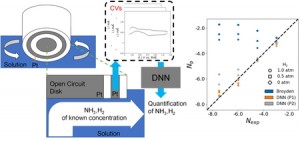[Published online Journal of Computer Chemistry, Japan -International Edition Vol.10, -, by J-STAGE]
<Title:> Development of a Simultaneous Quantification for Hydrogen and Ammonia Using Deep Neural Network and The Rotating Ring Disk Electrode Method
<Author(s):> Yusuke HIRUMA, Hyunho KANG, Hidenobu SHIROISHI
<Corresponding author E-Mill:> h-shiroishi(at)tokyo-ct.ac.jp
<Abstract:> Ammonia is considered as a viable candidate for a hydrogen carrier in a hydrogen-based society. Currently, real-time analysis of products in the development of highly active ammonia electrolytic synthesis catalysts is limited to the extremely expensive technique of electrochemical mass spectrometry. In this study, we aimed to develop a real-time simultaneous quantification method for hydrogen and ammonia concentrations using the rotating ring-disk electrode technique. We adopted deep neural network-based machine learning technology using the data from cyclic voltammogram (CV) measurements on a Pt ring electrode. The sum of squared residuals decreased to 1/0.645 at hydrogen partial pressure and 1/92.8 at ammonia concentration compared to the conventional combination of nonlinear least-squares method and solving simultaneous equations. Moreover, classifying concentrations through image recognition based on the obtained CV images resulted in successful concentration determination with an accuracy of 78.9%.
<Keywords:> Nitrogen reduction, Rotating ring disk, Real-time, Quantitative analysis, Deep neural network
<URL:> https://www.jstage.jst.go.jp/article/jccjie/10/0/10_2024-0011/_html
<Title:> Development of a Simultaneous Quantification for Hydrogen and Ammonia Using Deep Neural Network and The Rotating Ring Disk Electrode Method
<Author(s):> Yusuke HIRUMA, Hyunho KANG, Hidenobu SHIROISHI
<Corresponding author E-Mill:> h-shiroishi(at)tokyo-ct.ac.jp
<Abstract:> Ammonia is considered as a viable candidate for a hydrogen carrier in a hydrogen-based society. Currently, real-time analysis of products in the development of highly active ammonia electrolytic synthesis catalysts is limited to the extremely expensive technique of electrochemical mass spectrometry. In this study, we aimed to develop a real-time simultaneous quantification method for hydrogen and ammonia concentrations using the rotating ring-disk electrode technique. We adopted deep neural network-based machine learning technology using the data from cyclic voltammogram (CV) measurements on a Pt ring electrode. The sum of squared residuals decreased to 1/0.645 at hydrogen partial pressure and 1/92.8 at ammonia concentration compared to the conventional combination of nonlinear least-squares method and solving simultaneous equations. Moreover, classifying concentrations through image recognition based on the obtained CV images resulted in successful concentration determination with an accuracy of 78.9%.
<Keywords:> Nitrogen reduction, Rotating ring disk, Real-time, Quantitative analysis, Deep neural network
<URL:> https://www.jstage.jst.go.jp/article/jccjie/10/0/10_2024-0011/_html
